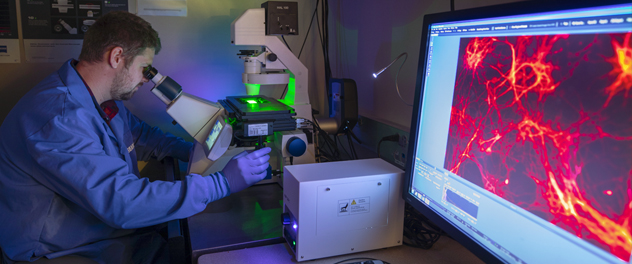Role of Alpha-Synuclein Oligomers in Disease
 Illuminating cellular mechanisms
Illuminating cellular mechanisms
The Neurobiology of Parkinson's Disease Lab uses advanced microscopy to understand disease processes.
Cytoplasmic deposition of alpha-synuclein aggregates is a common pathological feature of many neurodegenerative synucleinopathies, including Parkinson's disease and Lewy body dementia, and suggests a causative role of alpha-synuclein in these disorders. However, it is still uncertain whether macroscopic, fibrillar alpha-synuclein (Lewy bodies) or nonfibrillar, submicroscopic dimers or oligomers of alpha-synuclein cause neurodegeneration, although the accumulation of nonfibrillar oligomers is thought to play an important role.
Disease development and progression may be linked to processes that increase the rate at which alpha-synuclein forms these intermediate species due to the presumed toxic nature of oligomeric alpha-synuclein. If oligomeric forms of alpha-synuclein are toxic to cells, one therapeutic strategy is to reduce the rate at which oligomerization occurs or prevent oligomer formation altogether.
Current projects study the role of oligomeric alpha-synuclein in synucleinopathies, such as Parkinson's disease and dementia with Lewy bodies, and examine how specific modifications affect oligomer formation and oligomer-induced toxicity. To enable the direct study of alpha-synuclein oligomerization in living cells, the team has applied a strategy utilizing biochemical and biophysical tools, including a novel alpha-synuclein protein complementation assay. The oligomers that are detected using this assay are submicroscopic, soluble oligomers and not mature fibrillar inclusions. This assay allows rapid screening of modifications and therapeutic agents that target the oligomeric stage of fibrillization. This is where rescue of the soluble monomeric forms of alpha-synuclein could potentially rescue cell death and impact disease progression.
Discovering what forms of alpha-synuclein protein are toxic to neurons can help the research team in developing therapeutic strategies to target the specific forms of alpha-synuclein and stop cell death.